|
Warning - lots of pictures to come. For those still in the pre-broadband era this page may take some time to download. I'll do my best to minimize the pain by putting the text at the top so the pictures can download in the background while you read. |
|||||||
|
Arirang
Festival
|
|||||||
|
I'd heard and read plenty about this show before I came and had been kind of skeptical. A bunch of people flipping around colored squares? How cool could that be? Well, to put it mildly, my expectations were blown away. The show was spectacular, and somewhat eerie, all at the same time. If Orwell had put a stadium scene in 1984 this would have been it. How could 100,000 people, as everyone claimed anyway, all work together in such perfect harmony? Mr. Huk, who sat next to me throughout the performance and who always seemed brimming with fervor to show us nonbelievers the one true way, used the beauty of the performance to fill my ear, endlessly, with the utter, undeniable greatness of North Korea. For him this many people working together in lockstep precision was a sign that he and his countrymen were of one pure heart, of one pure mind, working together to fulfill the ideals of the Kims and Juche. "The people who come here for the performance are from all walks of life. Workers, students, soldiers, everyone who comes here is a volunteer. No one is paid. They do it because they love our country. The Arirang Festival shows how we can work together as one to achieve anything we desire, no matter who stands against us." Mr. Huk was polite enough not to point out the 'who' in this sentence meant me, or more specifically, my government. And of course the puppet government down in the South where I was living. The spectacle was something I'll never forget, though perhaps not for the reasons Mr. Huk and his countrymen intended. The show was so precise as to be robotic. No one outside the group, everyone buried within it. All done with a flair and focus that was chilling to behold. The model of mass unity that was being held up as proof of greatness and independence smacked of mindlessness. Of course everyone in the performance was human, with their own hopes, dreams and desires. This though was something to be eliminated, not tolerated or encouraged. These were things that still had to be rooted out in an effort to build the utopian, Juche-centered society. The zeal in Mr. Huk's voice spoke not of a country, but of a cult. [For another, similar take, please see The Economist's book review of B.R. Meyers' The Cleanest Race: How North Koreans See Themselves - And Why It Matters] |
|||||||
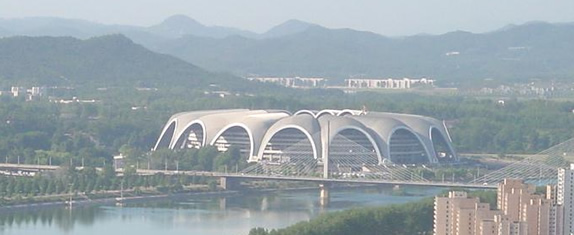 Daytime view of the Arirang Festival stadium Photo courtesy Thomas St. John |
|||||||
|
We pulled up to the stadium after a beautiful evening drive along the Taedong River. Our bus dropped us off right at the tourist entrance to the stadium, having passed hundreds of people along the way heading to join in or watch the show. The atmosphere was very friendly with people smiling and waving to us in the tour bus. As we walked up to the stadium we passed a small group of souvenir stands selling Arirang posters and t-shirts, North Korean stamps, and even a pizza vendor. Of course the guides told us we had no time to browse. We had to, "hurry, hurry, hurry" to get inside before the show started. They promised to allow us a few minutes to shop after the performance. As we walked into the giant stadium (of course one of the largest stadiums in the world, with a reputed capacity of 150,000) I was towards the front, looking for our '3rd Class' seats. The signs pointed up into the crowd and that's where I started to go, only to be stopped by Mr. Baek and Mr. Huk. Instead we were taken down to great seats right near the front, in a separate area roped off for tourists. Our travel agent in Beijing had been right - the $50 seats were fine. Anything more would have been a waste of money. From the stadium signs though we were obviously not in the 3rd class section. Best guess, unless we had bought the top of the line $300 tickets, we would have been in exactly the same section. |
|||||||
|
As we took our seats the mammoth size of the stadium became apparent. I've been to dozens of games at the University of Michigan's 110,000 person stadium and this place was noticeably larger. People were spread out getting ready on the field down below, as well as on the opposite side. Fortunately we had a few minutes to take pictures and look around before the performance was scheduled to begin. |
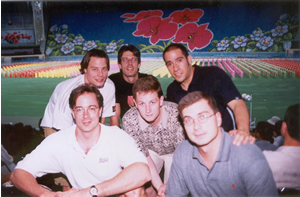 Taking our '3rd class' seats Photo courtesy Thomas St. John |
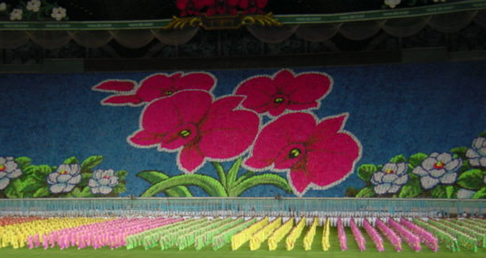 Warming up Photo courtesy Thomas St. John |
|
The sights unfolding across from us were amazing. The flowers you see in the picture above are part of one large image - a collage formed by 50,000 people holding large, colored cards above their heads. With a shout from the director a low roar would roll across the stadium as people flipped or switched their cards to make the next image. It was like a giant slide show only with the pictures being formed, one by one, by 50,000 people working in unison. A different image rolled across the whole far side of the stadium every couple of seconds, all coordinated with tens of thousands of other performers on the stadium floor. This was going to be something special . . . Prelude |
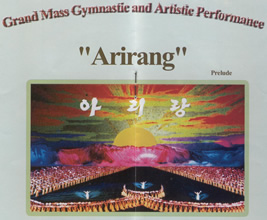 |
We had been given a festival program as we arrived. The event kicked off with a 'grand prelude', followed by four acts each with several scenes, and ended with a grand finale. The whole thing lasted over an hour. With some cajoling from the guides we all took our seats. I had Mr. Huk on my right ready to whisper the meanings of the images and scenes as they unfolded. With a hush the whole place went dark and the performance began. |
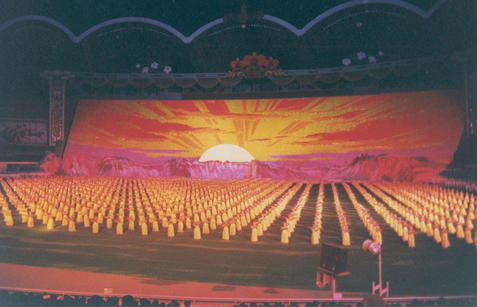 'Dawn' of the performance Photo courtesy Thomas St. John |
|
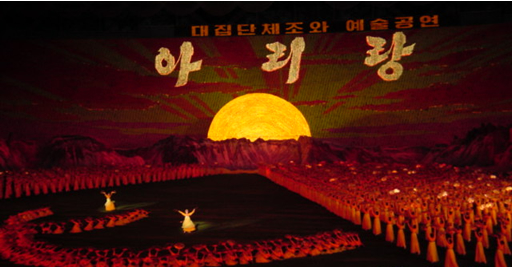 The large characters over the sun spell out 'Arirang' Photo courtesy Dan Harmon |
|
|
Act
1
|
|
 Official Arirang Program all program scans by Scott |
The lighting, music, pictures and performers were all minutely choreographed, with the images seeming to flow across the opposite side of the stadium. The only problem I had was trying to decipher what Mr. Huk was saying, while still keeping my eyes on the performance. When he told me it took 100,000 people to put on the show I didn't believe him at first. As the performance unfolded the masses of people marching in and out soon erased all doubts.
|
|
The was probably the most amazing scene. A wind seemed to rustle the trees, while above the star appeared to glimmer and shine. Remember, all done by people holding up cards. |
|
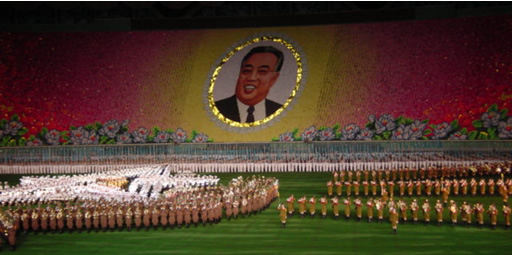 Kim Il-sung Photo courtesy Dan Harmon |
|
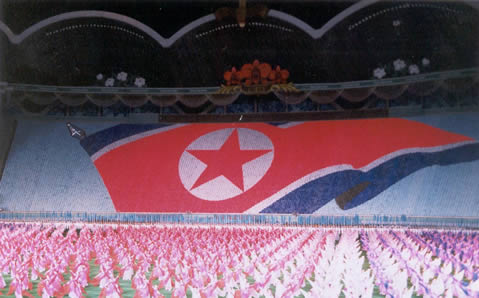 North Korean flag, with female performers dancing below. Photo courtesy Thomas St. John |
|
|
Act 2
|
|
|
Nationalism and the exalted position of the North Korean army were key underlying themes to the whole performance (if not the entire trip) and in the second act, Arirang of Army-centered Policy, it burst into the fore. Soldiers entered and dominated the stadium floor while martial images filled the stands. Mr. Huk beside me could barely contain himself. His enthusiasm to educate me on the wonders of the Glorious People's Army had him on an emotional high. The voice in my ear became louder and more insistent, he grabbed my arm for emphasis, all the while filling me in on the special meanings of each scene. |
Notice how similar the flag is to the giant sculptures at the Kim statue. The phrase here roughly translates as "Let's be able to take on the world". |
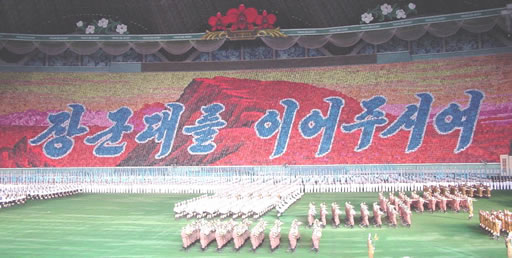 Roughly translated as 'together with the army' Photo courtesy Thomas St. John |
|
|
Notice
the soldiers having bayonet practice on the stadium floor. The lights
flashing off hundreds of shining bayonets were one of the more memorable
scenes of the show.
|
|
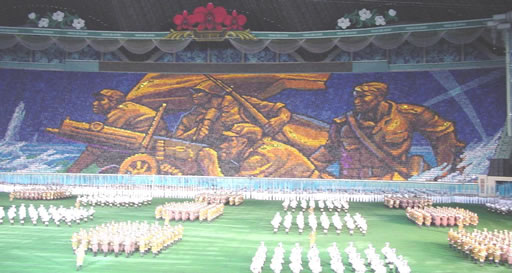 Machine gun unit with female soldiers parading in the foreground. |
|
|
Act
3
|
|
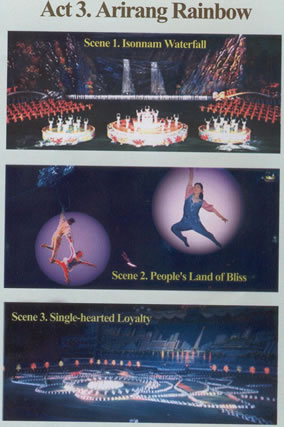 Scan of official program by Scott |
The third act was devoted mainly to political and economic messages stressing the current and future development of North Korean society. Mr. Huk delighted in telling me of the great advances made by DPRK researchers in economics, science, agriculture, and politics.
'The Dawn of the World' - here represented by land reform. True, in that the post-WWII land reform policy of the North Koreans was extremely useful in gaining popular support for the new government. |
|
For some reason the women dancing at the bottom of this picture are all holding tennis rackets . . . |
|
|
Ironic statement for a country that bars its citizens from international travel, non-government broadcasts, Internet access . . . It's so afraid of the Internet polluting the masses that DPRK official and quasi-official websites are run from Japan and China. |
|
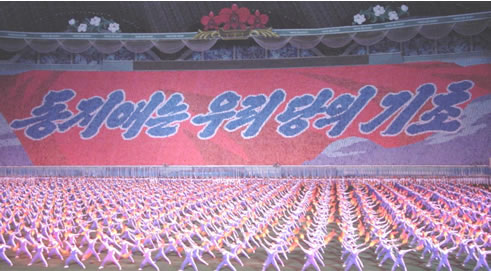 'Comrades are the Party's Foundation' Photo courtesy Thomas St. John |
|
|
A traditional folk dance common in both the North and the South. This scene should be familiar to anyone who's visited a folk village or traditional performance in the South. The colorful swirls are made by strips of fabric hung from the hats of the dancers. Very long movements are accomplished by standing on someone's shoulders, as shown. |
|
|
Act
4 and Finale
|
|
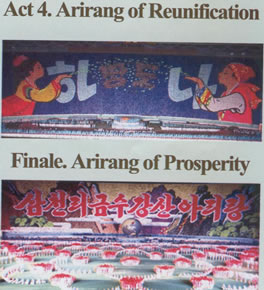 Scan of official program by Scott |
The fourth act and grand finale focused on Korean unification and the prosperity that would ensue throughout the peninsula should such a glorious event ever come to pass. When I told Mr. Huk that some South Koreans opposed unification because they worried it would cost too much to bring the North up to their level he looked as if I'd just slapped him. He had no comprehension of this idea at all. Instead, to him, I was just being a rude prick for saying such a ridiculous thing. After thinking about it for a moment he told me those people couldn't be true Koreans, instead they must be (and here he threw me an accusing look) US or Japanese lackeys. |
|
The unification scenes contained lots of references to Mt. Baekdu, an important place in both South and North Korean (where it's thought to be Dear Leader Kim Jong-il's birthplace) mythos. The mountain is located in the North along the border with China. It's not uncommon for South Korean tourists to travel to the Chinese side for a visit to the mythic mountain. |
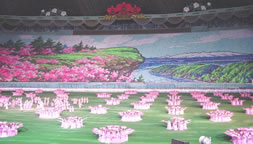 'Flowers of Mt. Baekdu' Photo courtesy Thomas St. John |
|
If you look closely you can see heads sticking out from behind the placards in the close-up above. |
The mountains and young dancers symbolize the bright future of Korean unification. |
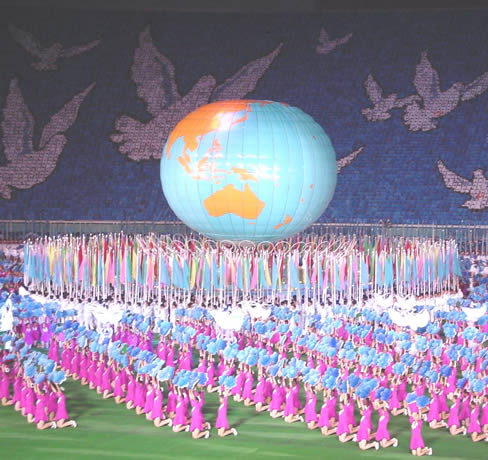 Finale - a peaceful world Photos courtesy Thomas St. John |
|
|
The final scene with thousands of performers crowding the floor of the stadium, and the crowd giving them a well-deserved standing ovation. |
|
|
The applause was barely beginning to die down before Mr. Baek and Mr. Huk had gotten together to hurry us out of the stadium. No relaxing and talking about the spectacle we had just witnessed while the crowd cleared, instead it was, "go, go, go." They dangled a carrot this time though, reminding us we would have some free time to shop at the souvenir stands once we got outside. We fought our way through the crowds to the outside where Mr. Baek was generous enough to offer us a whole 10 minutes to wander around and browse. After some debating we finally got him to push it to 15 minutes. Which, in retrospect, might have been the most stunning event of the entire evening . . . The pickings at the various stands were interesting but pretty slim. Some beautiful posters of the Arirang Festival, a huge variety of DPRK stamps, and some T-shirts so poorly made we were warned to frame them rather than wear them. The food vendors had mostly closed up shop - forcing me to miss my chance for pizza and a Coke in Pyongyang. Though something equally odd was about to happen. When I bought several sets of the six Arirang posters an amazing event took place. No, not a discount, but they threw in wrapping and a bag! Mr. Baek had worked with me on the purchase and was both pleased and pretty surprised at the fantastic deal he'd talked the vendor into. Getting something extra when making a bulk purchase - the evil ways of the capitalists were at last infiltrating the Juche bastions! As our 15 minutes wound up everyone straggled back to the appointed meeting place for the walk to the bus and ride back to the hotel. Our first day in North Korea had come to an end but tomorrow held what promised to be one of the most interesting parts of the whole trip - a visit to the DMZ. |
|
Video now available! Head to the North Korea Videos page to watch a clip. |
|
| 4. Yanggakdo Hotel |
6.
DMZ
|
||||
| Download Journey into Kimland as a single pdf (opens in new window). | |||||
|
Index
|
||
| 4. Yanggakdo Hotel | ||
| 5. Arirang Festival | 6. DMZ | |
| 7. Traditional Kaesong | 8. Pyongyang Circus | |
| 9. Mt. Myohyang | 10. Kim's Birthplace | |
| 11. Departure | ||
|
-
go to 1stopKorea homepage
|
|||||||
|
Copyright 1999-2007 1stopKorea
|
|||||||